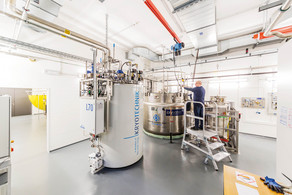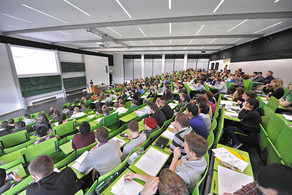Thesis defense of Felix Schwietert
- Defense
Microtubules are cylindrical cytoskeletal filaments. Their polymerization dynamics is characterized by a dynamic instability between phases of growth and shrinkage. The stochastic switches from shrinkage to growth and vice versa are called rescues and catastrophes, respectively. Experimental observations characterized the latter ones as multistep processes. In the first part of this thesis, we extend the empirical Dogterom–Leibler model of dynamic instability to discuss the effect that a multistep catastrophe mechanism has on the distribution of microtubule lengths in the two regimes of bounded and unbounded growth.We showthat, in the former case, the steady state length distribution is non-exponential and has a lighter tail if multiple steps are required to undergo a catastrophe. If rescue events are possible, we detect a maximum in the distribution, i.e., the microtubule has a most probable length greater than zero. In the regime of unbounded growth, the length distribution converges to a Gaussian distribution whose variance decreases with the number of catastrophe steps. In the mitotic spindle, microtubules attach to chromosomes via kinetochores, and their depolymerization forces give rise to stochastic chromosome oscillations during metaphase. In the second part of this thesis, we investigate the cooperative stochastic microtubule dynamics in spindle models consisting of ensembles of parallel microtubules, which are attached to kinetochores via elastic linkers. We include the dynamic instability of microtubules and forces on microtubules and kinetochores from elastic linkers. A one-sided model with a single kinetochore exposed to an external force is solved analytically employing a mean-field approach based on Fokker–Planck equations. The solution establishes a bistable force–velocity relation of the kinetochore. Coupling the kinetochores of two such bistable systems elastically in the full two-sided model gives rise to oscillations, which can explain stochastic chromosome oscillations in metaphase. We derive constraints on linker stiffness and microtubule number for these oscillations. Including poleward microtubule flux into the model, we can provide an explanation for the experimentally observed suppression of chromosome oscillations in cells with high flux velocities. Chromosome oscillations persist in the presence of polar ejection forces, however, with a reduced amplitude and a phase shift between sister kinetochores. Moreover, polar ejection forces are necessary to align the chromosomes at the spindle equator and stabilize an alternating oscillation pattern of the two kinetochores. Finally, we modify the model such that microtubules can only exert tensile forces on the kinetochore. Then, induced microtubule catastrophes after reaching the kinetochore are necessary to stimulate oscillations. The model parameters can be adapted to reproduce experimental results for kinetochore oscillations in PtK1 cells quantitatively. The microtubule-binding Ndc80 complex is an integral part of kinetochores and is essential to transmit forces from dynamic microtubule ends to the chromosomes. The Ndc80 complex has a rod-like appearance and its mechanical properties are considered important for the dynamic interaction between kinetochores and microtubules. In the final part of this thesis, we present a novel method that allows us to time-trace the effective stiffness of Ndc80 complexes following shortening microtubule ends against an applied force in optical trap experiments. Applying this method to wild type Ndc80 and three further variants, we reveal that each variant exhibits strain stiffening, i.e., the effective stiffness increases under tension that is built up by a depolymerizing microtubule. The strain stiffening relation is roughly linear and independent of the dynamic state of the microtubule. We introduce an elastic model, which shows that the strain stiffening can be traced back to the specific architecture of the Ndc80 complex and the bending elasticity of flaring protofilaments. The model reproduces the roughly linear strain stiffening behavior if a force-dependent binding affinity is taken into account.








